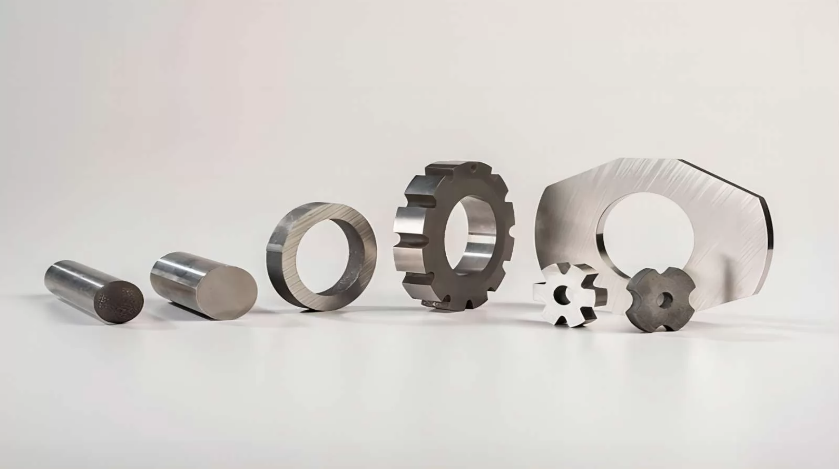Alnico magnets are a type of permanent magnet made from an alloy primarily composed of aluminum (Al), nickel (Ni), and cobalt (Co), along with iron and sometimes other elements like copper and titanium. Known for their excellent temperature stability and high magnetic strength, Alnico magnets were among the first strong permanent magnets developed and are still widely used in various applications today.
Directory Listing:
What are Alnico Magnets?
Composition and Manufacturing
Key Characteristics
Common Applications
Conclusion
What Are AlNiCo Magents?
While alnico magnets have largely been replaced by stronger rare-earth magnets, alnico are still commonly used in the manufacturing of sensors, guitar pickups, relays and high temperature handling equipment. Alnico magnets play a critical part in all electro permanent magnetic chucks and lifting magnets.
Alnico has a high magnetic strength and a low resistance to being demagnetised and re-magnetised. If coils of wire are wrapped around alnico magnets, they can be easily magnetised and demagnetised by electricity flowing through the coils. One hundred tonnes per square meter clamping chucks can be switched on and off in 0.2 seconds because of alnico magnets.
IN THE BEGINNING
The earliest reference to magnets dates back more than 2,500 years when magnetic lodestones were discovered and used by the ancient Greeks, although earlier civilisations may also have used the naturally occurring magnetic stones. The word magnet actually comes from the Greek word ‘Magnetis Lithos’ meaning ‘Magnesian Stone’ in reference to the area of now modern-day Turkey where the stones where found.
Did you know?The first magnetic material was discovered by the ancient Greeks over 2,500 years ago!
These lodestones were used as compasses by the world’s early navigators and explorers to locate the earth’s magnetic north and in 1600 William Gilbert published the first scientific study of magnetism called De Magenete. The first man-made magnets were not produced until 18th century and these were typically made out of ferromagnetic metals such as iron. Progress in creating stronger magnetic alloys was slow until the 1920s when an alloy of nickel, aluminium and cobalt was produced and named Alnico, a combination of Al (aluminium), Ni (nickel) and Co (Cobalt). The introduction of Alnico meant that expensive electromagnets could be replaced with permanent magnets in devices such as motors, generators and loudspeakers. During World War II Alnico magnets were used in military electronic applications.
Did you know?Before the introduction of rare-earth magnets, Alnico magnets were the strongest available.
Before the development of rare-earth magnets in the 1980s, alnico magnets were the strongest type of magnet available. Today, alnico magnets have largely been replaced by stronger rare earth magnets such as neodymium magnets. However, alnico magnets are still commonly used in the manufacturing of sensors, guitar pickups, loudspeakers and many other day to day household objects.
AL-NI-CO
Alnico magnets are permanent magnets that are primarily made up of a combination of aluminium, nickel and cobalt but can also include copper, iron and titanium. alnico magnets are available in either isotropic or anisotropic versions. The isotropic variety can be magnetised in any direction while anisotropic Alnico magnets can only be magnetised in one pre-defined direction and have a higher magnetic performance.

Composition and Manufacturing
In the casting process, the raw materials are melted together at high temperatures and poured into molds to create the desired shapes. This method allows for the creation of complex geometries and large sizes. Once the material has cooled and solidified, the cast magnets undergo a heat treatment process, which involves heating them to a specific temperature and then cooling them at a controlled rate. This heat treatment is crucial as it optimizes the magnetic properties of the Alnico alloy. The cooling process typically involves a magnetic field to align the magnetic domains within the material, enhancing its magnetic performance.
Sintering, on the other hand, involves pressing the powdered Alnico alloy into molds under high pressure to form a compact shape. The compacted powder is then heated in a vacuum or controlled atmosphere to a temperature below its melting point. This sintering process fuses the powder particles together to form a solid piece. Sintered Alnico magnets generally have better mechanical properties than their cast counterparts, although their magnetic strength is slightly lower. The sintering process also allows for the production of smaller and more precise shapes, which can be advantageous for certain applications.
After the initial forming and heat treatment processes, both cast and sintered Alnico magnets often undergo further machining and grinding to achieve the desired final dimensions and tolerances. This is possible due to the relatively high hardness and brittleness of the Alnico material, which can be precisely machined with the right equipment.
Finally, the magnets are magnetized by exposing them to a strong magnetic field, aligning the magnetic domains within the material. This step imparts the permanent magnetism that Alnico magnets are known for. The strength and orientation of the applied magnetic field can be tailored to achieve specific magnetic characteristics, depending on the intended application of the magnets.

Key Characteristics
Alnico magnets are distinguished by several key characteristics that make them valuable in various applications. These characteristics stem from their unique composition of aluminum, nickel, cobalt, iron, and sometimes copper and titanium.
One of the primary attributes of Alnico magnets is their exceptional temperature stability. They can operate effectively at temperatures up to 550°C (1,022°F) without significant loss of magnetic properties. This makes them ideal for high-temperature environments where other types of magnets might fail.
Alnico magnets also exhibit high residual induction, meaning they can generate strong magnetic fields. This high magnetic strength is useful in applications requiring powerful and consistent magnetic performance. Despite their strong magnetic fields, Alnico magnets have low coercive force, which means they are relatively easy to demagnetize and remagnetize. This property allows for easy reconfiguration of the magnetic field if necessary.
Another notable characteristic of Alnico magnets is their excellent corrosion resistance. Unlike some other types of magnets that require protective coatings to prevent rust, Alnico magnets naturally resist oxidation and corrosion. This makes them suitable for use in various environments, including those with exposure to moisture and chemicals.
Alnico magnets are also known for their durability and mechanical strength. While they are hard and brittle, making them somewhat susceptible to cracking or chipping if handled roughly, they are also resilient under normal operating conditions. Their hardness allows for precise machining, which can be advantageous in applications requiring specific shapes and sizes.
Furthermore, Alnico magnets retain their magnetic properties over long periods, making them reliable for applications requiring long-term stability. Their ability to maintain performance without significant degradation over time is a crucial factor in many industrial and scientific uses.

Advantages and Disadvantages of Ferrite Magnets
Advantages:
Affordability: Ferrite magnets are cheaper to produce than many other types of magnets.
Stability: They maintain their magnetic properties over a wide range of temperatures and operating conditions.
Resistance: They are resistant to demagnetization and corrosion, enhancing their longevity in various environments.
Limitations:
Magnetic Strength: Ferrite magnets are not as strong as rare-earth magnets like neodymium.
Brittleness: They are hard and brittle, making them susceptible to cracking under mechanical stress.
Size and Weight: For applications requiring high magnetic strength, ferrite magnets tend to be larger and heavier compared to neodymium magnets.
Conclusion
Ferrite magnets are versatile and economical magnets suitable for a variety of applications due to their moderate magnetic strength, excellent temperature and corrosion resistance, and cost-effectiveness. While they may not offer the same magnetic strength as neodymium magnets, their durability and stability make them a reliable choice for many industrial and commercial uses. When selecting magnets for your project, considering ferrite magnets can provide a balance of performance and affordability, especially in environments where high strength is not the primary requirement.
If you need a reliable manufacturer, then it is recommended to contact ketai ,ketai is a new high-tech enterprise specializing in R&D, production, processing and sales of NdFeB permanent magnet materials
 Hot News
Hot News2024-08-30
2024-08-30
2024-08-29
2024-08-29

Copyright © Ningbo Ketai Magnetic Material Co., Ltd. All Rights Reserved